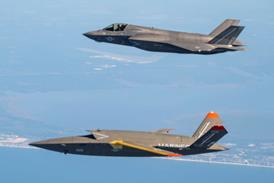Electronically scanned radar promises anti-ballistic missile solutions
Stewart Penney/LONDON
Proliferation of weapons of mass destruction and their delivery vehicles has forced the topic of ballistic missile defence (BMD) to the forefront of military research, development and requirements. So it is perhaps timely that British Aerospace Land & Sea Systems is about to test a multifunction active array radar. Its Multifunction Electronically Scanned Adaptive Radar (MESAR) 2 is a technology demonstrator programme that builds on nearly 20 years' work by BAe Land & Sea Systems and its predecessor companies.
Conventional radars suffer from limited power, are vulnerable to jamming and are restricted to a single function at any one time, such as surveillance or tracking. Many are also bespoke designs built with small numbers of high-value components, which make them expensive to procure and keep operational.
The air defence threat is becoming more sophisticated and the changing nature of military operations - such as the deployment of land forces out of area and the use of naval forces for coastal operations, rather than out at sea - promise to overwhelm conventional radar technology. Multifunction electronically scanned radars promise to be less expensive, with improved performance and the ability to counter emerging threats.
BAe has been developing active array radar since the late 1970s. Between 1982 and 1996 it worked on MESAR 1 with UK research and development contractors Roke Manor and the UK Defence Evaluation and Research Agency (DERA). Between 1989 and 1994 the system underwent trials against airborne targets. It led to Sampson, the multifunction radar selected by the UK Royal Navy for its next-generation air defence frigate (Flight International, 5-11 May).
In the BMD role, a MESAR 2-derived radar would provide long-range surveillance to detect missiles as they are launched. It would then automatically generate and maintain target tracks while using wideband waveforms to generate a high resolution image of the target to aid discrimination between the warhead and the less lethal missile body and motor. It would also be used as a fire control radar for anti-ballistic missile surface-to-air missiles.
MESAR 2 performs only a single task at any given time - like other multifunction radars - but it switches rapidly between functions while the array, or elements of it, can be "steered" to study a specific area. In rotating arrays a target can be held in the radar's view by steering the beam rather than it looking straight ahead.
Les Gregory, BAe Land & Sea Systems head of business development, says MESAR 2 has 10W transmit/receive modules - 1,264 of them - while MESAR 1 had 156 modules rated at 2W. Modules are grouped in sets of four which form line replaceable units. Despite the number of heat-generating electronic components, BAe retains air cooling of the array, rather than resorting to more complex and costly liquid cooling. MESAR 2 is instrumented to 400km (215nm) range and 90í elevation.
Gregory says an operational BMD radar would have "3,000, 4,000, 5,000 and 10,000 module versions". Radars with fewer modules stop scanning if the array "stares" at a target. Having more modules allows scanning to continue while part of the array locks on to the target, he adds.
MESAR 2 is operational at BAe's Cowes site on the Isle of Wight, south of the UK mainland, and has been "tracking targets at very long range" for some time, says Gregory. It is readily transportable, non-rotating and will deploy with display and processing cabins. UK trials late this year will be followed by US trials early next year.
Trials at DERA's ranges in the Hebrides Islands off Scotland's west coast will be divided into two parts, explains trials manager Jonathan Bluestone. If successful, MESAR 2 will acquire and track small bombs dropped from an aircraft while jamming is aimed at the scanner from comparatively close range. This will test the radar's ability to track "fairly small targets in clutter". BAe will also aim to "de-risk" US BMD trials by using MESAR 2 against ballistic targets fired at long range.
Gregory says trials at the White Sands Missile Range in New Mexico will "piggy back" US Ballistic Missile Defense Organization tests. BAe wants to track missile intercepts while MESAR 2 is at White Sands. This gives an understanding of how the radar would guide an interceptor if configured for missile control.
MESAR 2 uses commercial off-the-shelf components for processing and display, which provides part of the cost savings, says Gregory. The electronics use gallium arsenide semiconductors - a "fundamental technology" acquired with BAe's acquisition of the Siemens Plessey Systems company.
BAe "wants to move to a position where the system is a high capable radar antenna connected to a bespoke computer to meet [the customer's] requirements", says Gregory.
Results generated by MESAR 2 will be fed into a BMD dedicated radar system. Any development could be based on a rotating or non-rotating scanner. The USA and some Gulf states have ongoing BMD requirements.
Source: Flight International























